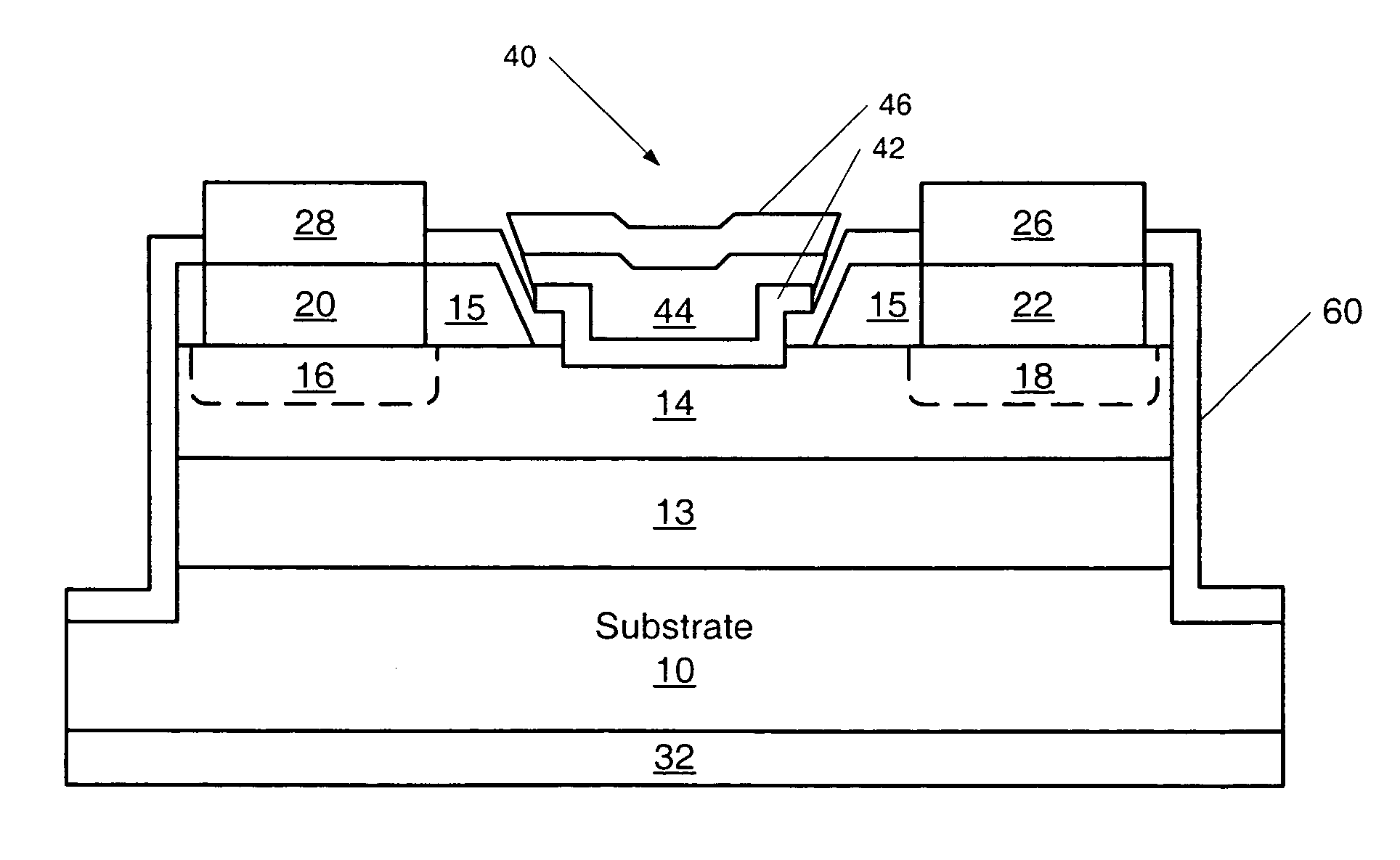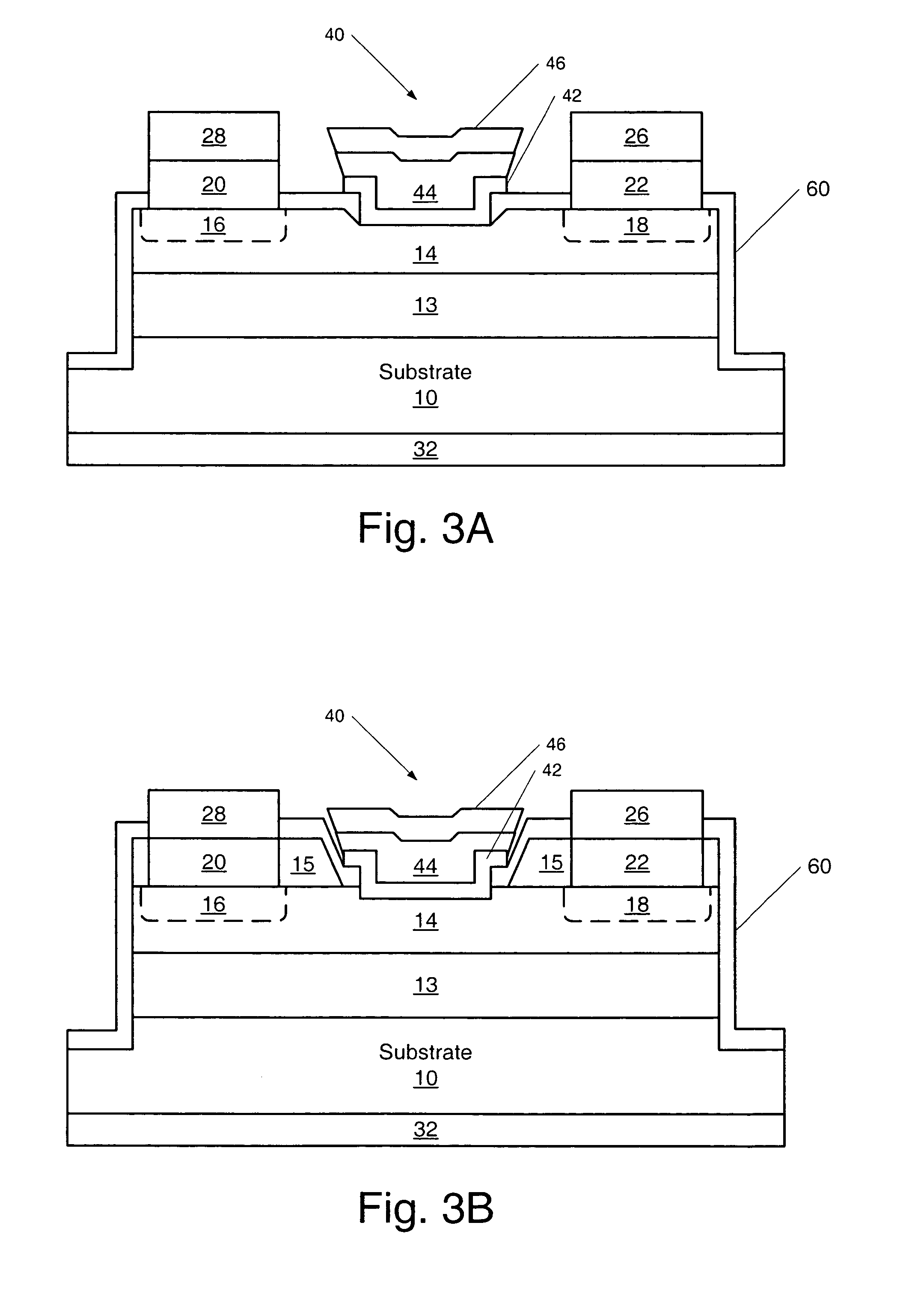Methods of fabricating silicon carbide metal-semiconductor field effect transistors
a metal-semiconductor field effect transistor and silicon carbide technology, applied in the field of microelectronic devices, can solve the problems of limited power handling capability of previously known jfets, high power and high frequency transistors usually generate larger amounts of heat, and achieve the effect of reducing back-gate effects and improving performan
- Summary
- Abstract
- Description
- Claims
- Application Information
AI Technical Summary
Benefits of technology
Problems solved by technology
Method used
Image
Examples
first embodiment
[0061]FIG. 1 illustrates a MESFET of the present invention. A first epitaxial layer 12 of p-type conductivity is grown on a single crystal bulk silicon carbide substrate 10 of either p-type or n-type conductivity or semi-insulating. The first epitaxial layer of silicon carbide 12 is disposed between the substrate 10 and an n-type epitaxial layer 14. An optional metallization layer, 32 may be formed on the opposite side of the substrate from the first epitaxial layer 12. The metallization layer 32 is preferably formed as described below with reference to FIG. 5.
[0062]The first epitaxial layer 12 may be a p-type conductivity silicon carbide epitaxial layer, an undoped silicon carbide epitaxial layer or a very low doped n-type conductivity silicon carbide epitaxial layer. If a low dope silicon carbide epitaxial layer is utilized, then it is preferred that the doping concentration of the first epitaxial layer 12 be less than about 5×1015 cm−3. If an undoped or n-type first epitaxial lay...
second embodiment
[0065]FIG. 2 illustrates a MESFET according to the present invention. As seen in FIG. 2, a selectively doped p-type epitaxial layer 12′ is formed on the substrate 10. The second n-type epitaxial layer 14 is formed on the selectively doped first p-type epitaxial layer 12′ and the source and drain contacts 20, 22 and Schottky metal contact 24 are formed on the n-type epitaxial layer 14. Also illustrated in FIG. 2 are optional n+ regions 16 and 18 formed in the source and drain regions of the device. If the n+ regions 16 and 18 are formed, it is preferred that these regions be formed by ion implantation of preferably phosphorous (P), although nitrogen (N) may also be used, followed by a high temperature anneal. Suitable anneal temperatures may be from about 1100 to about 1600° C.
[0066]Alternatively, the n+ regions 16 and 18 may be eliminated as described above so as to provide a device having the source, drain and gate structure illustrated in FIG. 1. In such a case, it is preferred th...
third embodiment
[0067]FIG. 3A illustrates a MESFET of the present invention where the Schottky gate contact 40 is recessed in the active channel layer. FIG. 3A also illustrates an embodiment of the present invention where the Schottky gate contact 40 is a mushroom gate contact. A first epitaxial layer 13 of p-type conductivity is grown on a single crystal bulk silicon carbide substrate 10 of either p-type conductivity, n-type conductivity or semi-insulating. The p-type epitaxial layer 13 may be a lightly doped p-type layer 12 as illustrated in FIG. 1 or a selectively doped p+ layer 12′ as illustrated in FIG. 2. A second epitaxial layer 14 of n-type conductivity is grown on the first epitaxial layer 13. Also illustrated in FIG. 3A are optional n+ regions 16 and 18 formed in the source and drain regions of the device which may be formed as described with reference to FIG. 2. The n+ regions 16 and 18 may be eliminated as described above with reference to FIG. 2 and illustrated in FIG. 1. Ohmic contact...
PUM
 Login to View More
Login to View More Abstract
Description
Claims
Application Information
 Login to View More
Login to View More - R&D
- Intellectual Property
- Life Sciences
- Materials
- Tech Scout
- Unparalleled Data Quality
- Higher Quality Content
- 60% Fewer Hallucinations
Browse by: Latest US Patents, China's latest patents, Technical Efficacy Thesaurus, Application Domain, Technology Topic, Popular Technical Reports.
© 2025 PatSnap. All rights reserved.Legal|Privacy policy|Modern Slavery Act Transparency Statement|Sitemap|About US| Contact US: help@patsnap.com



